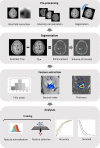Precise enhancement quantification in post-operative MRI as an indicator of residual tumor impact is associated with survival in patients with glioblastoma
- PMID: 33436737
- PMCID: PMC7804103
- DOI: 10.1038/s41598-020-79829-3
Precise enhancement quantification in post-operative MRI as an indicator of residual tumor impact is associated with survival in patients with glioblastoma
Abstract
Glioblastoma is the most common primary brain tumor. Standard therapy consists of maximum safe resection combined with adjuvant radiochemotherapy followed by chemotherapy with temozolomide, however prognosis is extremely poor. Assessment of the residual tumor after surgery and patient stratification into prognostic groups (i.e., by tumor volume) is currently hindered by the subjective evaluation of residual enhancement in medical images (magnetic resonance imaging [MRI]). Furthermore, objective evidence defining the optimal time to acquire the images is lacking. We analyzed 144 patients with glioblastoma, objectively quantified the enhancing residual tumor through computational image analysis and assessed the correlation with survival. Pathological enhancement thickness on post-surgical MRI correlated with survival (hazard ratio: 1.98, p < 0.001). The prognostic value of several imaging and clinical variables was analyzed individually and combined (radiomics AUC 0.71, p = 0.07; combined AUC 0.72, p < 0.001). Residual enhancement thickness and radiomics complemented clinical data for prognosis stratification in patients with glioblastoma. Significant results were only obtained for scans performed between 24 and 72 h after surgery, raising the possibility of confounding non-tumor enhancement in very early post-surgery MRI. Regarding the extent of resection, and in agreement with recent studies, the association between the measured tumor remnant and survival supports maximal safe resection whenever possible.
Conflict of interest statement
The authors declare no competing interests.
Figures



Similar articles
-
Correlation of the extent of tumor volume resection and patient survival in surgery of glioblastoma multiforme with high-field intraoperative MRI guidance.Neuro Oncol. 2011 Dec;13(12):1339-48. doi: 10.1093/neuonc/nor133. Epub 2011 Sep 12. Neuro Oncol. 2011. PMID: 21914639 Free PMC article.
-
Maximizing the extent of resection and survival benefit of patients in glioblastoma surgery: high-field iMRI versus conventional and 5-ALA-assisted surgery.Eur J Surg Oncol. 2014 Mar;40(3):297-304. doi: 10.1016/j.ejso.2013.11.022. Epub 2013 Dec 19. Eur J Surg Oncol. 2014. PMID: 24411704
-
Automated Volumetric Analysis of Postoperative Magnetic Resonance Imaging Predicts Survival in Patients with Glioblastoma.World Neurosurg. 2019 Jun;126:e1510-e1517. doi: 10.1016/j.wneu.2019.03.142. Epub 2019 Mar 22. World Neurosurg. 2019. PMID: 30910753
-
Role of Resection in Glioblastoma Management.Neurosurg Clin N Am. 2021 Jan;32(1):9-22. doi: 10.1016/j.nec.2020.08.002. Epub 2020 Nov 5. Neurosurg Clin N Am. 2021. PMID: 33223030 Review.
-
[Surgery of high-grade gliomas guided by fluorescence: a retrospective study of 22 patients].Neurochirurgie. 2013 Feb;59(1):9-16. doi: 10.1016/j.neuchi.2012.07.002. Epub 2013 Jan 12. Neurochirurgie. 2013. PMID: 23318102 Review. French.
Cited by
-
Resection of positive tissue on methionine-PET is associated with improved survival in glioblastomas.Brain Behav. 2023 Dec;13(12):e3291. doi: 10.1002/brb3.3291. Epub 2023 Oct 16. Brain Behav. 2023. PMID: 37846176 Free PMC article.
-
Comparative Clinical-Imaging and Histogenetic Analysis Between Astrocytoma IDH-Mutant Grade 4 and Glioblastoma IDH-Wildtype-Is There Really a Worse One?Diagnostics (Basel). 2025 Feb 11;15(4):438. doi: 10.3390/diagnostics15040438. Diagnostics (Basel). 2025. PMID: 40002588 Free PMC article.
-
Predicting the WHO Grading of Pediatric Brain Tumors Based on Their MRI Appearance: A Retrospective Study.Cureus. 2023 Oct 19;15(10):e47333. doi: 10.7759/cureus.47333. eCollection 2023 Oct. Cureus. 2023. PMID: 38021610 Free PMC article.
-
Advances in the In Vivo Quantitative and Qualitative Imaging Characterization of Gliomas.Cancers (Basel). 2022 Jul 8;14(14):3324. doi: 10.3390/cancers14143324. Cancers (Basel). 2022. PMID: 35884385 Free PMC article.
-
DeepEOR: automated perioperative volumetric assessment of variable grade gliomas using deep learning.Acta Neurochir (Wien). 2023 Feb;165(2):555-566. doi: 10.1007/s00701-022-05446-w. Epub 2022 Dec 19. Acta Neurochir (Wien). 2023. PMID: 36529785 Free PMC article.
References
Publication types
MeSH terms
LinkOut - more resources
Full Text Sources
Other Literature Sources
Medical

